Singapore Army
| Singapore Army | |
|---|---|
|
Tentera Singapura (Malay) 新加坡陆军部队 (Chinese) சிங்கப்பூர் தரைப்படை (Tamil) | |
|
Singapore Armed Forces Crest | |
| Founded | 12 March 1957 |
| Country |
|
| Type | Army |
| Size |
72,000 (active, including 35,000 conscripts) 350,000+ (reserve)[1] |
| Part of | Singapore Armed Forces |
| Motto(s) |
Yang Pertama Dan Utama (Malay) (First and Foremost) |
| Engagements |
Indonesia–Malaysia confrontation,[2][3][4] Iraq War Operation Enduring Freedom (as part of NATO-led ISAF) |
| Commanders | |
| Chief of Army | Major-General Melvyn Ong |
| Notable commanders |
Winston Choo Mancharan Singh Gill Ng Jui Ping Lim Neo Chian Han Eng Juan Lim Chuan Poh Ng Yat Chung Desmond Kuek Neo Kian Hong Chan Chun Sing Ravinder Singh Perry Lim |
| Insignia | |
| Flag |
 |
The Singapore Army is the service of the Singapore Armed Forces (SAF) tasked with land operations. It is the largest of the three Services. The Singaporean army is primarily a conscript army that, in the event of war, mobilises most of its combat power by calling up military reservists.
History
Two infantry regiments formed the nucleus of the Singapore Army. These were established pre-independence, in anticipation of self-rule following British decolonisation. The First Singapore Infantry Regiment (1 SIR) was constituted in 1957, under British auspices. The Second Singapore Infantry Regiment (2 SIR) followed in 1963. After a fraught merger with the Federation of Malaya and subsequent separation in 1965, newly-independent Singapore formally established its army by passing the Singapore Army Bill in December 1965.[5]
In 1972, Parliament passed further legislation (the Singapore Armed Forces Act) to reorganise and consolidate the armed forces' disparate commands and administrative functions.[6][7]
Military Deployments
- May 2007-June 2013, International Security Assistance Force. Deployment of close to 500 personnel including Singapore Army soldiers as part of Singapore's contributions to multinational stabilisation and reconstruction efforts in Afghanistan.[8]
- 2014–present, Military intervention against ISIL. Logistical support of coalition forces in the ongoing War on Terror.[9]
Strategic doctrine
The stated mission of the Singapore Armed Forces is to deter armed aggression, and to secure a swift and decisive victory should deterrence fail. The Army is also tasked with conducting peace-time operations to further Singapore's national interests and foreign policy. These range from disaster relief to peacekeeping, hostage-rescue and other contingencies.[10]
The Army views technology as a force-multiplier and a means to sustain combat power given Singapore's population constraints. Jointness across three branches of the SAF is integral to the Army's warfighting doctrine. Joint operations undertaken with the Navy and Air Force include amphibious landings and critical disaster relief operations in the aftermath of the 2004 Indian Ocean earthquake.
The Army has a technically proficient, relatively well-educated draftee pool and officer corps (non-commissioned and commissioned) reflective of the population at large, and has sought to leverage this to ease its transition into a more sophisticated, networked fighting force.[11]
Combat readiness is a linchpin of Army policy, and military exercises up to divisional level are conducted many times yearly, simulating full-spectrum operations, up to and including full-scale war. Divisional war games are a combined arms, tri-service affair involving the Republic of Singapore Navy and Air Force. Because training space is limited in Singapore—artillery fire would quickly traverse the island—some military exercises are conducted overseas. Reservists periodically [12] train abroad, their units regularly evaluated for combat readiness.[11] The Army also trains bilaterally with some host nations, and military exchanges are frequent. Training is billed as "tough, realistic and safe," with a premium on safety, given the sensitivity of military deaths in a largely conscript army.[10]
Following the Revolution in Military Affairs, and in tandem with modernizing its weapons systems, the Army is forging a transition to a more network-centric fighting doctrine that better integrates the Air Force and Navy.[13]
Organisation
| Singapore Army | |||||||||||
| |||||||||||
The Army is headed by the Chief of Army (COA). Assisting him are the Chief of Staff, Army General Staff[14] and Commander, TRADOC (Army Training and Doctrine Command).[15] There are six branches of the General Staff (G1-G6), a National Service Affairs Department (NSAD) dealing with National Service issues, and an Inspectorate. The six branches handle manpower (G1), intelligence (G2), operations (G3), logistics (G4), planning (G5) and training (G6) respectively. Each department is headed by an Assistant Chief of the General Staff (ACGS). Also advising the Chief of Army are the Senior Specialist Staff Officers (SSSOs) of the various formations (Infantry, Guards, Armour, Commandos, Artillery, Engineers and Signals).[16][17]
Chief of Army (COA)
| Years in Office | COA | Formation | Post-COA Career |
|---|---|---|---|
| 2015 — | Melvyn Ong | Guards | |
| 2014 — 2015 | Perry Lim | Guards | Chief of Defence Force |
| 2011 — 2014 | Ravinder Singh | Signals | President, ST Kinetics |
| 2010 — 2011 | Chan Chun Sing | Infantry | Acting Minister, Ministry of Community Development, Youth and Sports |
| 2007 — 2010 | Neo Kian Hong | Guards | Chief of Defence Force |
| 2003 — 2007 | Desmond Kuek | Armour | Chief of Defence Force |
| 2000 — 2003 | Ng Yat Chung | Artillery | Chief of Defence Force |
| 1998 — 2000 | Lim Chuan Poh | Infantry | Chief of Defence Force |
| 1995 — 1998 | Han Eng Juan | Armour | Chief Executive, Land Transport Authority |
| 1992 — 1995 | Lim Neo Chian | Combat Engineers | Chief Executive Officer, Jurong Town Corporation |
| 1990 — 1992 | Ng Jui Ping | Artillery | Chief of Defence Force |
Combat Arms
The Army consists of seven Combat Arms, from which are derived Divisional and Non-divisional units:
These are bolstered by Combat Service Support Units comprising the following:
- Army Intelligence
- Army Medical Services
- Army Maintenance and Engineering Support
- Army Supply and Transport
- Singapore Armed Forces Ammunition Command
Divisional and Non-Divisional assets
Combined-Arms Divisions
The Army's main organizational components are its Combined-Arms Divisions, of which there are three:[20] the 3rd, 6th and 9th Divisions.[21] They include both active and reserve units that are operationally ready, all subject to mobilization orders in the event of war.[12]
3rd Singapore Division (motto: "Foremost and Utmost") consists of the following subordinate units:
- HQ 3rd Singapore Division
- 3rd Singapore Infantry Brigade
- 5th Singapore Infantry Brigade
- 24th Singapore Infantry Brigade
- 30th Singapore Infantry Brigade
- 8th Singapore Armoured Brigade
- 3rd Division Artillery
- 3rd Division Support Command
Under the Division-National Cadet Corps (NCC) affiliation scheme, NCC West District is affiliated to the 3rd Division.
6th Singapore Division (motto "Swift and Deadly") consists of the following subordinate units:
- HQ 6th Singapore Division
- 2nd Singapore Infantry Brigade
- 9th Singapore Infantry Brigade
- 76th Singapore Infantry Brigade
- 54th Singapore Armoured Brigade
- 6th Division Artillery
- 6th Division Support Command
- 6th Division Engineers
- 6th Divisional Air Defence Artillery Battalion
- 6th Signal Battalion
Under the Division-NCC affiliation, NCC Central District is affiliated to the 6th Division.
9th Division/Infantry (motto: "Forging Ahead) consists of the following subordinate units:
Organisation:
- HQ 9th Singapore Division
- 10th Singapore Infantry Brigade
- 12th Singapore Infantry Brigade
- 56th Singapore Armoured Brigade
- 9th Division Artillery
- 9th Divisional Support Command
- 9th Signal Battalion
Under the Division-NCC affiliation, NCC East District is affiliated to the 9th Division/Infantry.
MINDEF Reserve (MR) NS Divisions
2 People's Defence Force
2 People's Defence Force (PDF) is responsible for homeland security, including that of key civilian installations and infrastructure. 2 PDF is also responsible for the coordination and secondment of military resources to civilian agencies in the event of a civil emergency.[22]
Organisation:
- HQ 2 PDF
- HQ 21 Singapore Infantry Brigade
- HQ 22 Singapore Infantry Brigade
- HQ 26 Singapore Infantry Brigade
- HQ 27 Singapore Infantry Brigade
- HQ 29 Singapore Infantry Brigade
- HQ 32 Singapore Infantry Brigade
- 8th Battalion Singapore Infantry Regiment (8 SIR)
- 9th Battalion Singapore Infantry Regiment (9 SIR)
21st Division
Designated as Army Operational Reserve (AOR), the 21st Division is a rapid deployment force of highly mobile infantry (Singapore Guards) specializing in amphibious, heliborne, and maneuver warfare. The armoured and artillery components of the division are lightweight, amphibious, and rapidly deployable.
Organisation:
- 7th Singapore Infantry Brigade
- 13th Singapore Infantry Brigade
- 15th Singapore Infantry Brigade
- Divisional Artillery
- 21st Signal Battalion
- 21st Divisional Support Command
- 18th Divisional Air Defense Artillery Battalion
- Divisional Combat Engineer Battalion
Of the three infantry brigades, one is active and staffed mainly by career servicemen. Two are held in reserve, one tasked with heliborne operations, the other tasked with amphibious landings.[23]
25th Division
Also designated as Army Operational Reserve (AOR).
Organisation:
- 11th Singapore Infantry Brigade
- 14th Singapore Infantry Brigade
- 63rd Singapore Infantry Brigade
- 65th Singapore Infantry Brigade
32nd Division
Tim Huxley speculates in Defending the Lion City that "the reorganisation of 1991 and 1995 left one armoured brigade, 4 SAB, outside the divisional structure, prompting speculation that it has been earmarked to form the core of a conceptualised new mechanised division." Huxley asserts that it was "initially codenamed as 32nd Division at the planning stage."[24] Beyond speculation, there is no indication that the division was ever constituted.
Non-Divisional Units, some appended to the General Staff
- Military Intelligence Battalion (1MIBN – 1st Military Intelligence Bn)
- Commandos Battalion (1CDO – 1st Commando Bn)
- Special Operations Task Force – joint task force consisting of the Naval Diving Unit, Commandos and the Special Operations Force
- Aggressor Company – subordinate to TRADOC/ATEC, this company-sized detachment organizes itself according to the hypothesized enemy's order of battle and acts as the OPFOR in training evaluations. They are the 'red' opposing force in ATEC evaluations.
- Medical Response Force (MRF) – Company-sized counter-chemical and -biological warfare unit, staffed by combat medics.
- Heavy Tank Battalion – 48 SAR
- Armoured Brigade – 4 SAB
Equipment
Photo gallery
 Another photo of Singapore Army's Leopard 2A4 at the Singapore Airshow 2008.
Another photo of Singapore Army's Leopard 2A4 at the Singapore Airshow 2008. AMX-10PAC 90 with the 90mm main gun
AMX-10PAC 90 with the 90mm main gun SM-1 Launched Bridge (SLB)
SM-1 Launched Bridge (SLB).jpg) M728 Combat Engineer Vehicle (CEV)
M728 Combat Engineer Vehicle (CEV).jpg) FV180 Combat Engineer Tractor (CET)
FV180 Combat Engineer Tractor (CET) The Vehicle Launched Bridge
The Vehicle Launched Bridge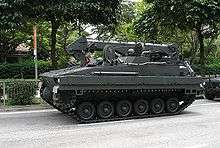 The Bionix Armoured Recovery Vehicle (ARV)
The Bionix Armoured Recovery Vehicle (ARV)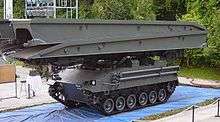 The Bionix Launched Bridge (BLB)
The Bionix Launched Bridge (BLB)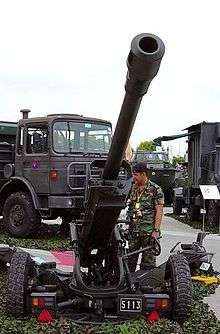 The 105mm Giat LG-1 howitzer at the SAF Open House
The 105mm Giat LG-1 howitzer at the SAF Open House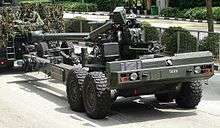 FH-2000 in towing configuration
FH-2000 in towing configuration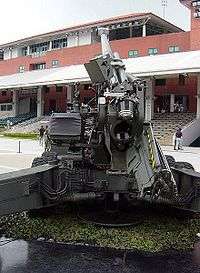 Open breech of FH-2000 as seen from loader position
Open breech of FH-2000 as seen from loader position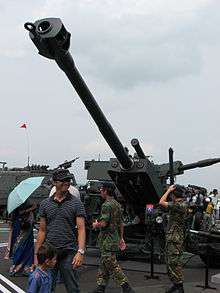 The SLWH Pegasus at the Singapore Airshow 2008
The SLWH Pegasus at the Singapore Airshow 2008 The 155mm/39calibre Singapore Self-Propelled Howitzer 1 (SSPH 1)
The 155mm/39calibre Singapore Self-Propelled Howitzer 1 (SSPH 1) SPIKE ATGM complete with mock-up missile
SPIKE ATGM complete with mock-up missile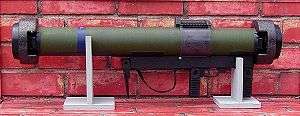 The MATADOR (Man-portable Anti-Tank, Anti-DOoR)
The MATADOR (Man-portable Anti-Tank, Anti-DOoR)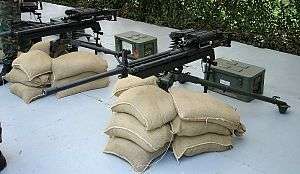 The new CIS-50 12.7mm Heavy Machine Gun
The new CIS-50 12.7mm Heavy Machine Gun
See also
- Singapore Armed Forces
- Republic of Singapore Air Force
- Republic of Singapore Navy
- Singapore Special Operations Force
- Singapore Armed Forces ranks
References
- Notes
- ↑ http://www.globalfirepower.com/country-military-strength-detail.asp?country_id=singapore
- ↑ "1957 – Our First Battalion". MINDEF. Retrieved 22 March 2010.
- ↑ "1963 – Konfrontasi". MINDEF. Retrieved 22 March 2010.
- ↑ "1963 – Pioneering Spirit of 2 SIR". MINDEF. Retrieved 22 March 2010.
- ↑ "The Singapore Army Is Established". HistorySG. National Library Board Singapore. Retrieved 25 February 2016.
- ↑ "Singapore Armed Forces Act". Retrieved 25 February 2016.
- ↑ "Singapore Armed Forces Come Into Effect". HistorySG. National Library Board Singapore. Retrieved 25 February 2016.
- ↑ "Singapore Armed Forces Concludes Deployment in Afghanistan". Retrieved 25 February 2016.
- ↑ "Joint Statement Issued by Partners at the Counter-ISIL Coalition Ministerial Meeting". Office of Website Management, Bureau of Public Affairs. Office of the Spokesperson, Washington, DC. Retrieved 25 February 2016.
- 1 2 "The Singapore Army- About Us". MINDEF.
- 1 2 Tim Huxley, Defending the Lion City, Allen & Unwin, 2000, p.65.
- 1 2 "NS Matters - Home". Retrieved 24 December 2014.
- ↑ "The 3rd Generation SAF". MINDEF.
- ↑ "The Singapore Army - Organisation Structure". Retrieved 24 December 2014.
- ↑ http://www.mindef.gov.sg/imindef/publications/cyberpioneer/news/2011/mar/28mar11_news.html
- ↑ "gov.sg — Directory". Retrieved 24 December 2014.
- ↑ "gov.sg — Directory". Retrieved 24 December 2014.
- ↑ "The Singapore Army - Armour". Retrieved 24 December 2014.
- ↑ "The Singapore Army - Artillery". Retrieved 24 December 2014.
- ↑ "gov.sg — Directory". Retrieved 24 December 2014.
- ↑ See also http://web.archive.org/web/20091027094953/http://geocities.com/mindef123/Army.html, and Huxley, Defending the Lion City, 2000, p.123-6
- ↑ "The Singapore Army - 2 People's Defence Force". Retrieved 24 December 2014.
- ↑ Tim Huxley, Defending the Lion City, Allen & Unwin, 2000, p.124.
- ↑ Tim Huxley, Defending the Lion City, Allen & Unwin, 2000, p.127. Huxley's source note on 32nd Division appears to refer to an article by defence journalist Prasun Sengupta (1992, p.76), but Huxley's bibliography is incomplete.
- Bibliography
- Tim, Huxley. Defending the Lion City: the Armed Forces of Singapore. Publisher: Allen & Unwin Pty LTD, 2000. ISBN 1-86508-118-3.
- Further reading
- 'Singapore's Army: boosting capabilities,' Jane's Intelligence Review, April 1996
External links
| Wikimedia Commons has media related to Singapore Army. |
- Official website
- Singapore Army Official Ranks Website
- Ranks and Paramilitary Ranks of Singapore, accessed 23 October 2006.
- Singapore Infantry Regiment pictures and info
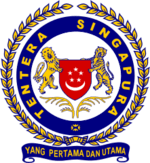


.svg.png)